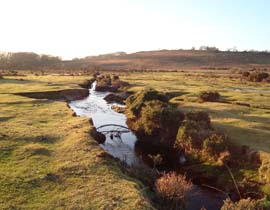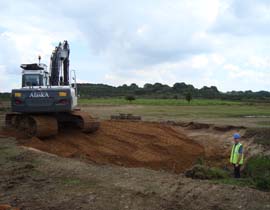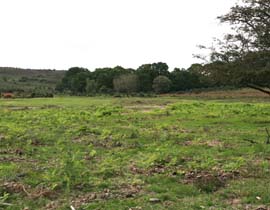What are the issues?
 The SSSI units in this valley were in unfavourable declining condition due to the effects of artificial drainage, which caused increased erosion of the river bed and limited channel habitat diversity.
The SSSI units in this valley were in unfavourable declining condition due to the effects of artificial drainage, which caused increased erosion of the river bed and limited channel habitat diversity.
There was limited seasonal inundation of the surrounding grassland and heathland habitats and inconsistent interaction with the floodplain, with the effect that the adjacent habitats were negatively affected (see left for photo before restoration).
How have we fixed them?
The remedy identified that has rated the condition of this unit to unfavourable recovering was to restore the original meandering course of the Ditchend Brook and then infill the redundant (drain) channel.
In addition, the straight drain line running through Must Thorns Bottom from Pitts Wood Inclosure was infilled, with the meandering course upstream linked in to natural drainage channels flowing through the dry heath to the south.
 This was a continuation of earlier stream restoration work carried out upstream in 2008 within Pitts Wood Incl osure. Because Ditchend Brook is situated within the former Live Target Area of the Ashley Walk Bombing Range, active from 1940 to 1946. It was necessary to engage suitably qualified contractors to safely locate, clear and dispose of any remaining ordnance before any restoration work began in the area.
This was a continuation of earlier stream restoration work carried out upstream in 2008 within Pitts Wood Incl osure. Because Ditchend Brook is situated within the former Live Target Area of the Ashley Walk Bombing Range, active from 1940 to 1946. It was necessary to engage suitably qualified contractors to safely locate, clear and dispose of any remaining ordnance before any restoration work began in the area.
The two gravel fords at this site, one over the Ditchend Brook and one beside Pitts Wood Inclosure were retained for future operational and public access purposes.
See photo above during restoration and below for photo after restoration.

Addendum 2014- Repairs to Ditchend
The initial restoration at Ditchend had, in places, shown signs of becoming unstable leading to renewed erosion in places.
Visual observation and technical assessment revealed that the energy in the watercourse was excessively contained in the restored channel. When the water is confined to the channel, and energy is restricted from spreading across the floodplain width, the erosive force can lead to scour, incision and vertical erosion.
The FC is committed to ensuring that the stream restorations are effective and maintained where necessary. These works are a demonstration of this commitment.
The repairs involved additional bed level raising to reduce the capacity of the watercourse channel. If the channel’s bed level is raised to promote floodplain inundation during times of high flows, the flow can be slowed to reduce the stream’s ability to transport sediment. The larger stone cobbles used as bed substrate replicates the situation found in naturalised high energy stream locations, with the larger stones being less likely to be transported by the water.